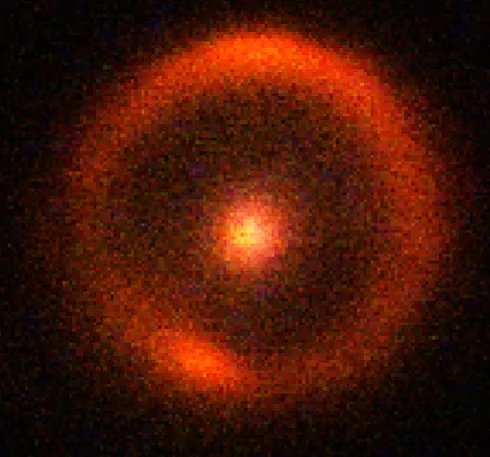
Gravitational lensing in action. At the centre of this infrared image is a massive red galaxy, 9.8 billion lightyears from Earth, which acts like a cosmic magnifying glass, distorting the light from an even more distant galaxy, 17.3 billion lightyears away
Image: David Lagattuta/WM Keck Observatory
A team of researchers from the US and the Netherlands has discovered a dwarf galaxy rich in dark matter lying 10 billion lightyears from Earth. It is only the second such galaxy ever discovered outside of the Milky Way. The new discovery could have implications for our understanding of dark matter.
Galaxies such as our own are believed to have formed from the merger of previous smaller galaxies. This process should have left lots of dwarf galaxies scattered around any large galaxy as satellites – for the Milky Way, models predict up to 10,000 of these satellite galaxies, but to date only 30 have been seen.
“It could be that many of the satellite galaxies are made of dark matter, making them elusive to detect – or there may be a problem with the way we think galaxies form,” said Simona Vengetti, a post-doctoral researcher in physics at MIT and lead author of the paper documenting the new discovery in the journalNature.
Although a long, long way from the Milky Way, the new galaxy is a dwarf satellite of precisely the kind that is ‘missing’ from around our own. It was detected using the Keck Telescope in Hawaii, thanks to a process called ‘gravitational lensing’.
This technique involves studying the light from two sources (in this case, galaxies) that, from an Earthly point of view, appear aligned in the sky. The gravity of the nearer object acts as a lens, deflecting light from the further one; by studying exactly how that light is deflected, scientists are able to determine whether there is anything in orbit around the object.
Now that the technique has proved itself suitable for the detection of small satellite galaxies, the hunt is on for more of them. “Now we have one dark satellite, but suppose we don’t find enough of them?” said Vengetti. “We will have to change the properties of dark matter.”
If, for instance, the number of satellite galaxies discovered falls short of projections, that may tell us something new about the temperature of dark matter, since temperature is key in determining the mass and number of satellite galaxies formed. “Or, we might find as many satellites as we see in the predictions,” said Vengetti, “which will tell us that dark matter has the properties we think it has.”